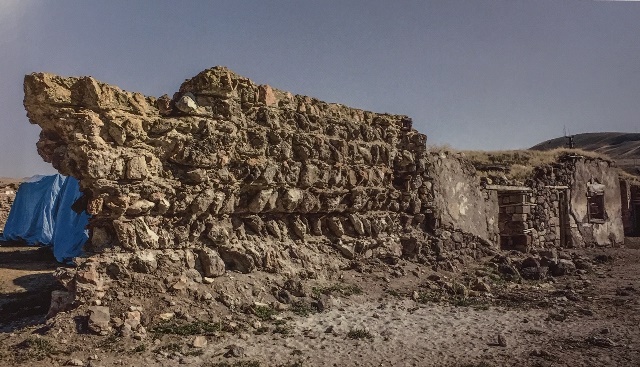The Seljuk Han of Anatolia
KOPRUKOY HAN
An eastern han on the road to Iran, mentioned in a 14th century travel guide written by an Italian merchant.
|
Karpuz, Anadolu Selçuklu Eserleri (2008) v.1 p. 319. |
 Bilici, vol. 2, p. 27 |
DISTRICT
25 ERZURUM
LOCATION
39.972562, 41.873772
The Köprüköy Han is located in the middle of the town of Köprüköy near Erzurum, opposite the hospital.
The Köprüköy Han appears to have been an important stop along the route to Tabriz. It was built along the trade route that led from Erzurum to Khoy (western Azerbaijan), Marand, and Tabriz. It was situated at the juncture of a much-used road from Iran into Anatolia. The location of this han along this strategic point along the route is indicated by the many travelers en route to Iran stopped at this han and noted it and the bridge in their travel journals. The fact that so many travelers mentioned this han shows that it must have been an important stop. In a 14th century manual for merchants, the Florentine broker Francesco Pegolotti (d. after 1347) listed the toll stations along the route from the port of Ayas to Tabriz. He based his manual on the accounts of other traders who had used the Anatolian routes, since he himself never traveled to Anatolia. The Köprüköy Han may correspond to the stop Pegolotti called Polerbech. Other travelers mentioning this han include the Frenchman Tavernier (1630), Tournefort 1701), A. Pushkin (1829), the American missionaries E. Smith and H. Dwight (1830). J. Hamilton, who visited the han in 1842, said that the han was made of cut stone with four support towers, but was in a ruined state: "...in the small village of Keupri Keieui a few hundred yards beyond which are the ruins of an ancient khan or caravanserai built in the rich Saracenic style, of solid stone, once cased with good masonry, the greater part of which has been removed. Each side is defended by four round towers, while the entrance is from the south through an outer and inner doorway. Over the outer doorway are handsome arabesque carvings, above which the wall is hollowed out like the upper part of a Gothic niche. The inner doorway is ornamented in the same style, but not so richly. Within is a vast stable, about 25 ft high, with five rows of arches on each side."
DATE
It is considered to have been built around 1300.
The Köprüköy Han, with its late 13th or early 14th century date, together with the presence of the Şerafeddin Ejder Han in the same region, show the degree of trade that existed between Anatolia and Ilkhanid Iran. It is not known who built this han, but its existence does indicate there was a greater interest in developing the trade routes in the late 13th century to focus on the Black Sea, Trebizond and Tabriz, and to develop the caravanserai network in northeastern Anatolia, a region where the Seljuks never built much, other than the string of hans built by Mahperi Hatun in the Tokat region in the 1240s. The construction of this han shows that there was a need to enforce the caravanserai network in northeastern Anatolia, a region where the Seljuks never built much, but where the Mongols sought to develop trade to parry their financial needs.
It is believed that it was built at the same time as the nearby Çoban Dede Bridge.
PATRON
This han has been attributed to Choban Noyan (?-1327), who was governor of Anatolia under the Mongols. This attribution, however, like that of a nearby bridge known as the Çoban Dede Bridge, relies on the account of the 17th century Ottoman traveler Evliya Çelebi, rather than any surviving inscriptions.
DESCRIPTION
Only a few walls remain standing. It is known almost entirely and known only from excavations. The elaborate double door and the decorative stones of which spoke Hamilton have long disappeared.
BIBLIOGRAPHIC REFERENCES
Bilici, Z. Kenan. Anadolu Selçuklu Çaği Mirası. Mimarı = Heritage of Anatolian Seljuk Era. Architecture. 3 vols. Ankara: Türkiye Cumhuriyeti Cumhurbaşkanlığı: Selçuklu Belediyesi, 2016, vol. 2, p. 27.
Blessing, Patricia. Rebuilding Anatolia after the Mongol Conquest: Islamic Architecture in the Lands of Rum, 1240-1330. Farnham: Ashgate Publishing, 2014. (Birmingham Byzantine and Ottoman Studies; 17), pp. 174-178.
Erdmann, Kurt. Das Anatolische Karavansaray des 13. Jahrhunderts, vol 1. Berlin: 1961, no. 101, pp. 203-204.
Gündoğdu, Hamza. Köprüköy Hani. Ataturk Universitesi Güzel Sanatlar Enstitüsü Dergisi 4, 1998: pp. 79-90.
Hamilton, W. Researches in Asia Minor, 1842, p. 184.
Karpuz, H. & Kuş, A. & Dıvarcı, I. & Şimşek, F. Anadolu Selçuklu Eserleri, 2008, v.1 p. 319.
Özergin, M. Kemal. Anadoluda Selçuklu Kervansarayları, Tarih Dergisi, XV/20, 1965, p. 156, nr. 76.
Pegoletti, Francesco Balducci. La Pratica della Mercantura. ed. Allan Evans, Cambridge, MA., 1936.
©2001-2025, Katharine Branning; All Rights Reserved.